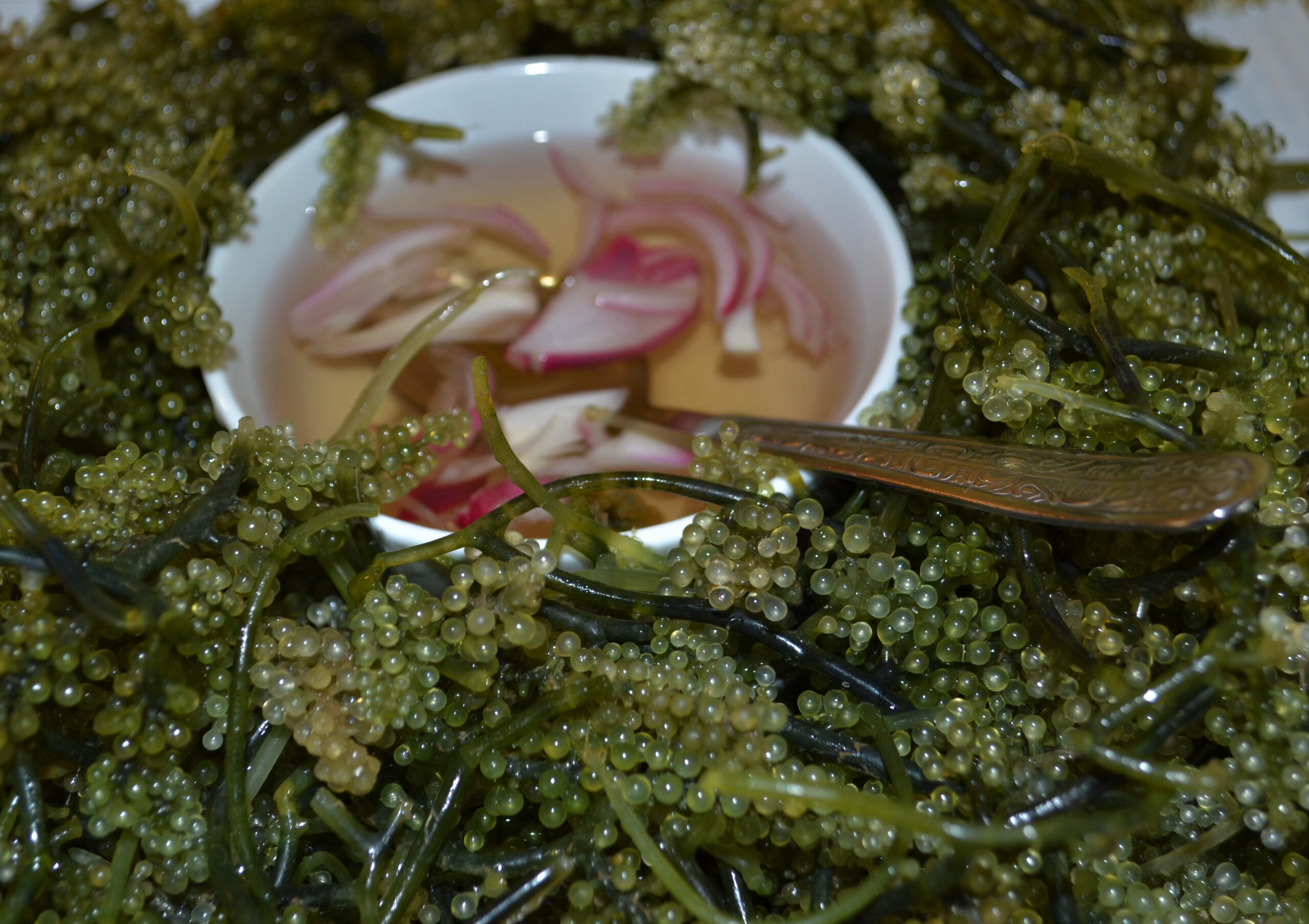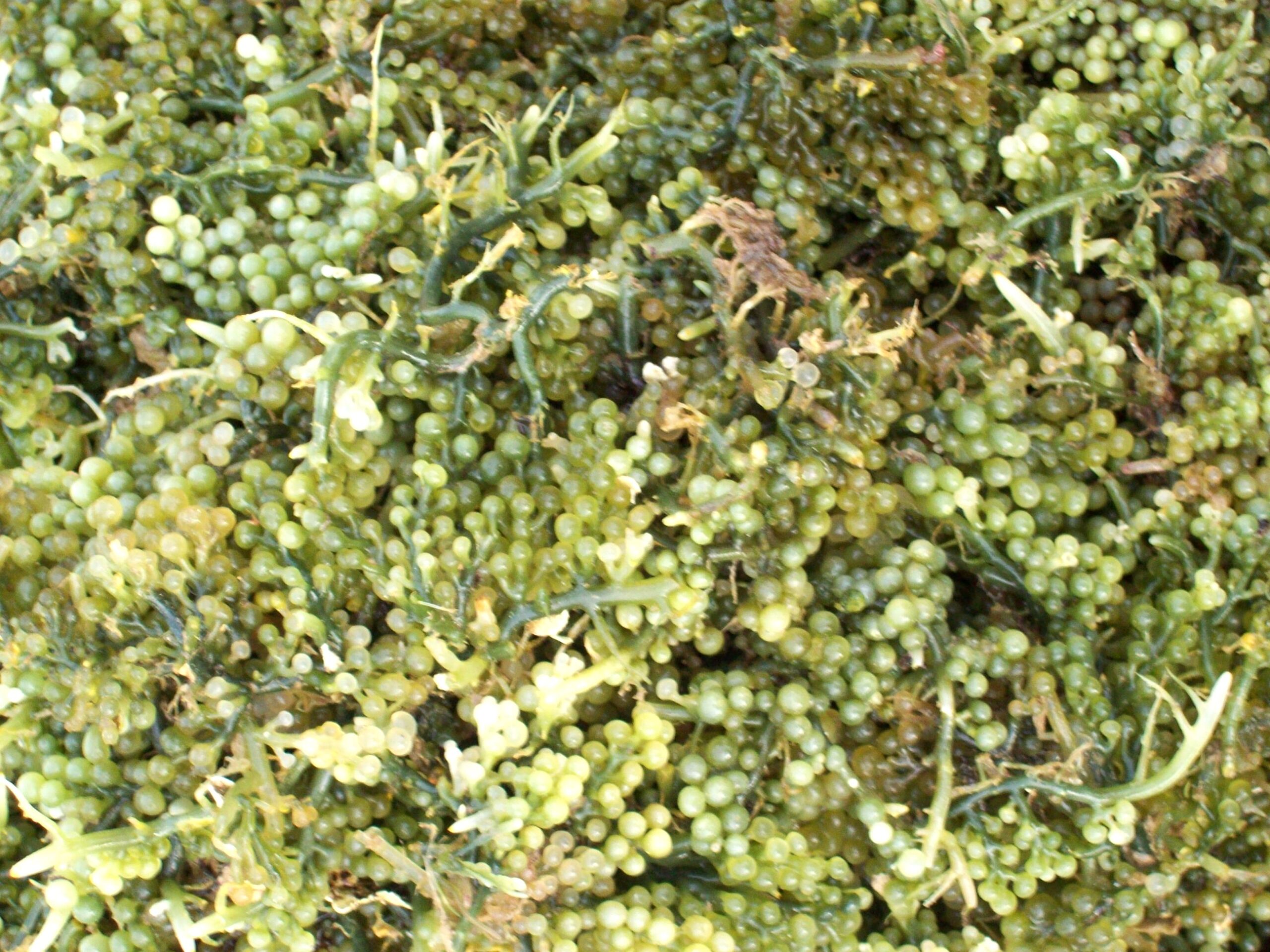Text and Photos by Henrylito D. Tacio
A lot of Filipinos love seaweeds. There are several species, but the most favored is the edible Caulerpa lentillifera due to its soft and succulent texture. Its colors are bright green to bluish and olive green. Traditionally, it is eaten in the cuisines of Southeast Asia, Oceania, and East Asia.
In the Philippines, it is called lato or arosep. It is rinsed clean with cool water to remove the slightly fishy smell. Usually, it is eaten raw as a salad (called ensaladang lato), mixed with chopped onions and fresh tomatoes, and dressed with a blend of fish sauce or bagoong (fish paste) and vinegar.
In the past, lato were harvested directly from the wild. The Filipinos cultivated it commercially in the 1950s in Cebu after the accidental introduction of lato to fish ponds. These days, lato are usually harvested after two months from the first planting and every two weeks afterwards – depending on growth rates.
Japanese followed commercial cultivation in 1986. Cultivated in tanks in the warmer waters of Okinawa, they umi-budo or kubiretsuta. Like Filipinos, the Japanese eat it raw with soy sauce or a mix of soy sauce, vinegar, and mirin. It’s actually a kind of side dish that anyone can find in many restaurants. It can be found on everything – from sushi to ice cream. Curiously enough, it also goes well with beer.
The Philippines and Japan are the top consumers of this seaweed species. However, its cultivation has spread to other countries, including China (particularly Fujian and Hainan), Taiwan, and Vietnam.
The seaweed is also eaten in Vietnam, where it is known as rong nho or rong nho bien. In Korea, it is called bada podo, while in Indonesia, people living in Bali call it bulung. It is also popular in the Malaysian state of Sabah, where it is known as latok.
In English, it is called green caviar. But generally, however, it is called sea grapes due to its appearance that looks like tiny clusters of green grapes. The “bubbles” are actually the leaf part of this underwater plant. They grow on a long stem that is also edible. So, no part of it is wasted.
Those who have not tasted it might be wondering how sea grapes taste? It tastes slightly salty with an oceanic freshness to it. But there are those who think sea grapes taste either sweet or sour, like acidic flavor. “The taste is like a combination of wine, grapes, and a little cocktail,” someone said.
But sea grapes lovers would definitely tell you that the best thing about it is its texture. After all, the little bubbles burst in the mouth when eaten. The Japanese call this a “puchi puchi” texture, which is an onomatopoeia used to refer to the popping sound of the burst of air bubbles.
Seagrapes are packed with vitamins and minerals. “They are considered a good source of vitamins A and C, calcium, zinc, and iron,” reports the website favy-jp.com. “They also contain a high level of vegetable protein per calories and a good amount of omega-3 fatty acids, too.”
Seagrapes contain less sugar but are rich in polyunsaturated fatty acids. It also contains carbohydrates, sodium, potassium, copper, manganese, dietary fiber, vitamin B2, vitamin E, vitamin K, folate, and biotin.
Now, let’s talk about the health benefits you can get from eating sea grapes.
Nutrition experts claim 100 grams of sea grapes contain about 1.8 milligrams of iodine. By eating at least 30 grams of sea grapes, you get the sufficient iodine needed for the thyroid. As such, they help prevent goiter.
The Philippine Thyroid Diseases Study done in 2012 showed the prevalence of thyroid function in the country is 8.53% among the adult population. Among the thyroid disorders, goiter is the most common, with a prevalence rate of 10.12%.
As sea grapes are rich in calcium, potassium, and vitamin C, they are effective in reducing blood pressure due to the ability to promote excretion and maintain normal blood pressure for people with hypertension.
More importantly, sea grapes strengthen eyesight and heart health. As they contain unsaturated fatty acids, they help to enhance eyesight and memory. They also lower cholesterol, enhance the fluidity of blood vessels, prevent oxidation, and maintain the collagen structure of the skin in the arteries. In like manner, they help prevent cardiovascular diseases such as stroke, atherosclerosis, and myocardial infarction.
Seagrapes are good for people with diabetes. As they contain very low calories and sugar, they help control blood sugar level and activity of free radicals, decrease intracellular of sorbitol and inhibit the binding of glucose and protein, thus reducing complications of diabetes.


Seagrapes are also found to be good for people experiencing stress and depression. “It is a natural origin of the B vitamins pyridoxine (B6) and pantothenic acid (B5),” notes the website drhealthbenefits.com. “These are the energy vitamins that regulate the adrenal glands from turning exhausted during a period of high pressure. Without B vitamins, we become easily tired, and we don’t think brightly.”
Another reason why you need to eat sea grapes: avoidance of cancerous cells. “Lignans are the origin of seaweed’s cancer-destroying properties,” drheatlbenefits.com says. “As a matter of fact, many cultures that eat a heavy number of sea grapes such as Japan and Korea have a population with very few examples of these deadly diseases.”
But sea grapes have other uses, too. “Aside from being a high value food item, recent scientific studies point to its industrial and biomedical uses,” reports the Poseidon Ocean Sciences, Inc. (POSI). “Seaweeds, in general, possess many bioactive ingredients that are now in common use in the cosmetic industry as additives to give high value to topical formulations, such as anti-inflammatory, skin lightening and other benefits.”
POSI adds, “It is very likely that sea grapes may possess biopharmaceutical attributes as more research is focused towards this direction. A concerted effort to utilize this resource in identifying promising ingredients open new opportunities that may provide unique cosmetic benefits. Since sea grapes can be grown all year round under controlled conditions, it is possible to maximize the production of such ingredients.”
Seagrapes, anyone?

